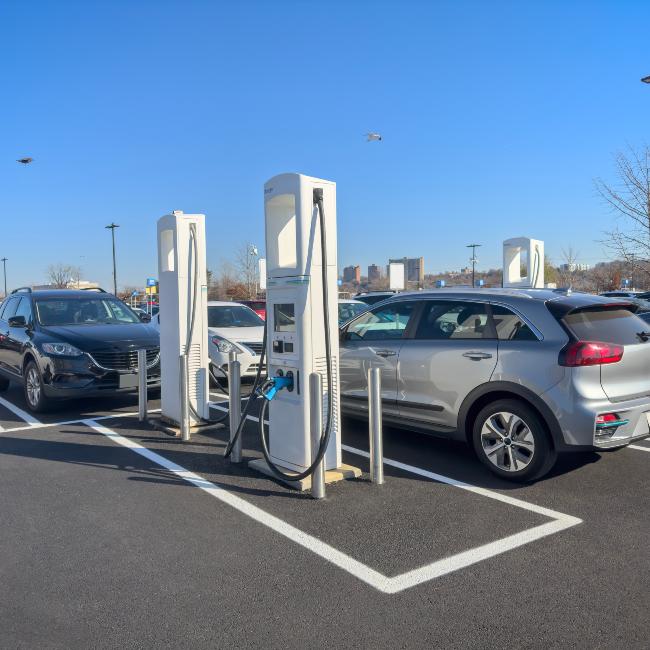-
Can't Find What You're Looking For? Start a Custom Order.
- Ford Custom Order
- CDJR Custom Order

Electric vehicles (EVs) have evolved considerably in the last decade, offering an increasingly viable alternative to traditional internal combustion vehicles. However, not all EVs are created equal. This guide aims to shed light on the different types of electric vehicles, their features, advantages and limitations, and how they fit into the broader landscape of transportation solutions aimed at reducing carbon emissions.
Battery Electric Vehicles (BEVs)
Overview
BEVs are the purest form of electric vehicles, running solely on electrical energy stored in their onboard batteries. These vehicles have no internal combustion engines, relying entirely on their electric motors for propulsion.
Features and Benefits:
- Zero Emissions – Being fully electric, they emit no tailpipe pollutants.
- Low Operating Costs – Fewer moving parts mean lower maintenance costs.
- Charging Convenience – Can be charged at home or at public charging stations.
Limitations
- Limited Range – Most BEVs have a range of 150-370 miles per charge, depending on the model.
- Charging Time – Even with fast chargers, BEVs usually take longer to refuel compared to gasoline vehicles.
Plug In Hybrids (PHEVs)
Overview
PHEVs combine an internal combustion engine with a battery and an electric motor. The vehicle can run on electric power for short distances and switch to the gasoline engine for longer trips.
Features and Benefits
- Flexibility – Capable of running on electric power, gasoline, or a combination of both.
- Range – Can achieve longer distances by utilizing the internal combustion engine.
- Emissions Reduction – Lower emissions when operating in the electric mode.
Limitations
- Complexity – More components mean potentially higher maintenance costs.
- Reduced Electric Range – Typically offer shorter all-electric ranges compared to BEVs.
Hybrid Electric Vehicles (HEVs)
Overview
HEV’s also combine an internal combustion engine with an electric motor but lack the plug-in capability. The battery is charged through regenerative braking and the internal combustion engine.
Features and Benefits
- Fuel Efficiency – Highly efficient, especially in stop and go traffic.
- Convenience – No need to plug in for charging.
- Lower Emissions – Although not zero emissions, they are better than traditional cars.
Limitations
- Limited Electric Range – Usually can only run on electric power for short distances at low speeds.
- No Plug-In – Cannot be charged externally, limiting its electric only capabilities.
Fuel Cell Electric Vehicles (FCEVs)
Overview
FCEVs use hydrogen gas to power an electric motor. Unlike BEVs, which store electricity in a battery, FCEVs generate electricity on-board by combining hydrogen and oxygen in a fuel cell.
Features and Benefits
- Quick Refuelling – Hydrogen refuelling is as quick as gasoline refuelling.
- Zero Emissions – Only by product is water vapor.
- Longer Range – Generally offer longer ranges compared to BEVs.
Limitations
- Infrastructure – Hydrogen refuelling stations are few and far between.
- Cost – High csost of hydrogen production and fuel cell components.
Solar Electric Vehicles (SEVs)
Overview
SEVs are a nascent technology that incorporates solar panels into their designs. They are generally built as BEVs with the added ability to charge using solar energy.
Features and Benefits
- Sustainability – The epitome of green driving by using renewable solar energy.
- Reduced Charging Costs– Able to generate some of their power independently.
Limitations
- Inefficiency – Solar panels are not yet efficient enough to fully power a vehicle.
- Cost – Higher upfront costs due to the addition of solar panels.
E-Bikes and Electric Scooters
Overview
While not cars, e-bikes and electric scooters are increasingly popular forms of electric transportation for shorter distances.
Features and Benefits
- Convenience – Ideal for city commuting and short trips.
- Low Cost – Much less expensive that electric cars.
Limitations
- Limited Range – Typically, only suitable for short commutes.
- Weather Dependent – Not ideal for use in poor weather conditions.
The Road Ahead
As technology advances, these types of electric vehicles will continue to evolve, offering greater range, quicker charging times, and lower costs. Governments and corporations are also making strides to improve the infrastructure, making it easier for consumers to choose electric.
Conclusion
Understanding the different types of electric vehicles can help you to make an informed decision that fits your needs and contributes to a more sustainable future. Each type of EV offers a unique set of benefits and limitations, but all of them move us closer to a greener and more sustainable form of transportation.
For over 50 Years V&H Automotive has been serving Marshfield and Central Wisconsin with New Ford, Lincoln, Chrysler, Jeep, Dodge, and RAM Trucks. Our professional staff of factory trained sales associates, as well as parts and service personnel, are here to serve you six days a week. Our business managers will shop more than a dozen lenders to ensure you the lowest rates anywhere. From Wausau to Wisconsin Rapids, or Stevens Point to Medford – we’re a short drive from anywhere for friendly service and very competitive pricing. If you have any automotive needs, check out our website or contact us at 715-387-2545. Better yet, stop in for a visit!




